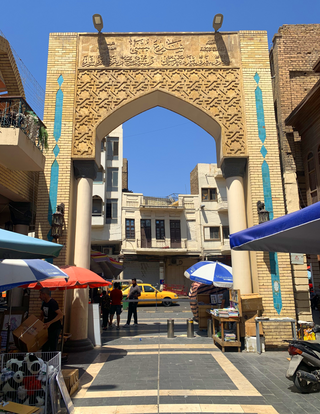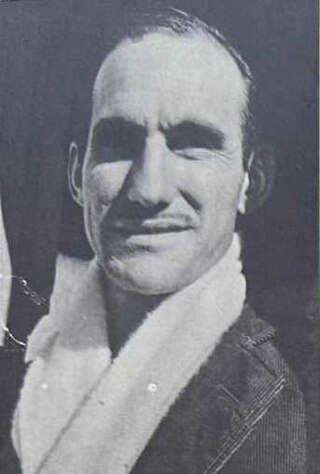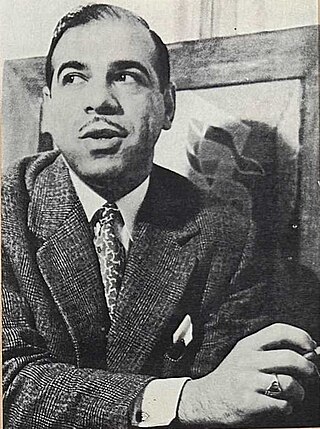Noori al-Rawi (1925-2014) was an Iraqi painter; a pioneer of Iraqi art who played an important role in shaping the Iraqi modern art movement through his roles as a practising artist, author, television presenter, art administrator and art critic.
Noori al-Rawi (1925-2014) was an Iraqi painter; a pioneer of Iraqi art who played an important role in shaping the Iraqi modern art movement through his roles as a practising artist, author, television presenter, art administrator and art critic.

Noori al-Rawi was born in 1925 in Rawa, Al Anbar, Iraq, in the fertile, agricultural lands between the Euphrates River and the mountains and near the Babylonian city of Anah. [1] This rural setting provided him with a lifelong source of inspiration, based on landscapes, villages and village life, all of which became his preferred subject matter. [2]

In his youth, he spent much of his time in the Baghdad Library, where he met the poet, Badr Shakir al-Sayyab, who lived in a government apartment nearby. The pair developed a friendship, and through this connection, al-Rawi learned about Iraq's ancient legacy in art and poetry. [3]
Al-Rawi began his working career teaching drawing and art, after having graduated from a local teachers' college. He later received a formal art education first at Baghdad University, and later at the Institute of Fine Arts, graduating in 1959. He subsequently received a scholarship to study print editing and television program production in Belgrade (1962). [4]
He was one of the pioneers of modern art in Iraq, producing a rich body of paintings and sculptures. [5] An active participant in Iraq's arts community, he was a founding member of the Baghdad Modern art group. [6] This group aimed to reassert a national identity through art and literature, by developing artworks with a distinctive Iraqi identity which referenced its ancient heritage and tradition. [7]
Although a prolific painter of some note, he is mostly remembered for his roles as an art historian, art critic and art administrator. He was one of the key founders of Baghdad's National Museum of Modern Art (1962) and served as its Director from 1962 to 1974, responsible for acquiring the artworks that would comprise the core collection. His focus for the collection was to acquire works along two parallel lines, the first was Iraqi art, and the second was Arabic paintings. [8] This was a challenging period for the museum in particular, and Iraqi art more generally, as the arts were seriously under-funded. [9] He was also instrumental in founding several other art museums including: the Pioneer Museum, the Faik Hassan Museum and the Iraqi Museum of Creativity. [10] He also established the first bronze smelter for use by local sculptors. [11]
He was a prolific writer and became a respected media presenter, using his position to promote the distinctive character of Iraqi art and cement Iraq's position at the forefront of contemporary pan-Arab art. From a very early stage in his career, he published articles in the magazines, Al-Rafidain and Al-Manahil. [12] The first to establish regular arts page in the Iraqi press, and supervised its editing. Established in 1952 and known as Time, News and Voice of the Free, the art page was instrumental in creating public interest in local art. [13] He was the editor of the New Iraq Magazine and Journal of the Gallery. [14] Later, he presented arts programs for Baghdad Television for some thirty years (1957-1987). [15]
He died in Baghdad on 13 May 2014 at the age of 89. [16]


His paintings often merge representation with abstraction. The traditional Iraqi town is a recurring theme in his paintings. [17] A large number of his paintings were stolen or destroyed during the 2003 looting of the Museum of Modern Art in Baghdad. [18]
He authored one of the first books on Iraqi art, Reflections on Modern Iraqi Art, as well as six other titles dealing with various aspects of art history and related themes: [19]

Jewad Selim (1919–1961) was an Iraqi painter and sculptor born in Ankara, Ottoman Empire in 1919. He became an influential artist through his involvement with the Iraqi Baghdad Modern Art Group, which encouraged artists to explore techniques that combined both Arab heritage and modern art forms. He is considered to be one of Iraq's greatest 20th-century sculptors.
Faeq Hassan (1914–1992) was an Iraqi painter noted for founding several 20th century art groups, which collectively were responsible for bridging the gap between Iraqi heritage and traditional art and modern art. He is often called the 'father of Iraqi modern art.'

Ismail Fatah Al-Turk was an Iraqi painter and sculptor born in Basra, Iraq, noted for his abstract art, monumental sculpture, and public works and as part of the Baghdad Modern Art Group, which fostered a sense of national identity. His monument, al-Shaheed Monument is the most iconic public monument in Baghdad.
Nedim Kufi, born 1962 in Baghdad), is an Iraqi-Dutch multi disciplinary visual artist. He is primarily known for conceptual art that explores themes such as war, political conflict, exile, loss, and historical memory. Much of his work contains autobiographical elements. He is also a graphic designer and print maker.

Al-Mutanabbi Street is located in Baghdad, Iraq, near the old quarter of Baghdad; at al-Rasheed Street. The street is the historic center of Baghdad bookselling, a street filled with bookstores and outdoor book stalls. The street was named after the 10th-century classical Iraqi poet al‑Mutanabbi and has been referred to as the heart and soul of the Baghdad literacy, and intellectual community.

Shakir Hassan Al Said (1925–2004), an Iraqi painter, sculptor and writer, is considered one of Iraq's most innovative and influential artists. An artist, philosopher, art critic and art historian, he was actively involved in the formation of two important art groups that influenced the direction of post-colonial art in Iraq. He, and the art groups in which he was involved, shaped the modern Iraqi art movement and bridged the gap between modernity and heritage. His theories charted a new Arabic art aesthetic which allowed for valuations of regional art through lenses that were uniquely Arabic rather than Western.
Mahmoud Sabri was an Iraqi painter who was considered to be one of the pioneers of Iraqi modern art and one of the pillars of modernism in Iraqi art.
Hanaa Malallah is an Iraqi artist and educator living in London, England. Her surname also appears in English as Mal-Allah. She is noted for developing the technique called the Ruins Technique in which found objects are incorporated into artwork.

Dia Al-Azzawi is an Iraqi painter and sculptor, who lives and works in London. He is one of the pioneers of modern Arab art and is noted for incorporating Arabic script into his paintings. Active in the arts community, he founded the Iraqi art group known as New Vision and has been an inspiration to a generation of young, calligraffiti artists.

Iraqi art is one of the richest art heritages in world and refers to all works of visual art originating from the geographical region of what is present day Iraq since ancient Mesopotamian periods. For centuries, the capital, Baghdad was the Medieval centre of the literary and artistic Arab world during the Abbasid Caliphate, in which Baghdad was the capital, but its artistic traditions suffered at the hands of the Mongol invaders in the 13th century. During other periods it has flourished, such as during the reign of Pir Budaq, or under Ottoman rule in the 16th century when Baghdad was known for its Ottoman miniature painting. In the 20th century, an art revival, which combined both tradition and modern techniques, produced many notable poets, painters and sculptors who contributed to the inventory of public artworks, especially in Baghdad. These artists are highly regarded in the Middle East, and some have earned international recognition. The Iraqi modern art movement had a profound influence on pan-Arab art generally.
The One Dimension Group was a modern art collective founded in Iraq, by Shakir Hassan Al Said in 1971 which attempted to combine medieval Sufi traditions with contemporary, abstract art. Although the One Dimension Group was founded in Iraq, its members originated from across Arab nations, and its influence was felt across the Arab art world.
The Hurufiyya movement (Arabic: حروفية ḥurūfiyyah adjectival form ḥurūfī, 'of letters' is an aesthetic movement that emerged in the second half of the twentieth century amongst artists from Muslim countries, who used their understanding of traditional Islamic calligraphy within the precepts of modern art. By combining tradition and modernity, these artists worked towards developing a culture-specific visual language, which instilled a sense of national identity in their respective nation-states when many of these states were shaking off colonial rule and asserting their independence. They adopted the same name as the Hurufi, an approach of Persian Sufism which emerged in the late 14th–early 15th century. Art historian Sandra Dagher has described Hurufiyya as the most important movement to emerge in Arabic art in the 20th century.

Jamil Hamoudi (1924–2003) was an Iraqi artist who became the Director of the Ministry of Culture's Fine Arts Department. He is noted for his involvement in various Iraqi and Arabic art movements including the Hurufiyya movement which bridged the gap between traditional and modern Iraqi art.

Khaled Al-Rahal was an Iraqi painter and sculptor and one of the leaders of the modern art movement in Iraq. Described as one of the "pillars of modern Iraqi art," he was responsible for executing a number of high-profile public monuments in Baghdad in the mid-20th century.

Hafidh Al Droubi (1914-1991) was an Iraqi painter and draughtsman, noted for his Cubist paintings and for his approach to professionalising Iraqi art education in the early to mid 20th-century. He was a prolific painter, an important artist in the Pioneer generation, a key figure in the development of modernism in Iraq and a key figure in the development of early Iraqi art education.
Rafa al-Nasiri was an Iraqi painter, draughtsman, print-maker, educator and author whose works with a social and political message resonated with the Iraqi public in the mid-20th century. He was also very influential in encouraging young artists to take up print-making.
Mun'im Furat (1900-1972) was an Iraqi primitive artist, noted for his sculptures resembling Sumerian statuary. His style was very distinctive and he was the only Iraqi artist to produce works in the naive style.
Faraj Abbo al Numan, more commonly Faraj Abu, Faraj Aboo or simply Faraj Abou, was an influential Chaldean Iraqi artist, theatre director, designer, author and educator, noted as one of the early artists to integrate Arabic script into his abstract paintings and who achieved international recognition for his artwork.
Kadhim Haydar (1932–1985) was a highly respected Iraqi artist, poet, author, stage-set designer and educator who, as part of the first generation of modern Iraqi artists, had a major influence on the direction of modern Iraqi art. His artworks are noted for their use of symbolism, myth and poetic allegory within a contemporary framework.